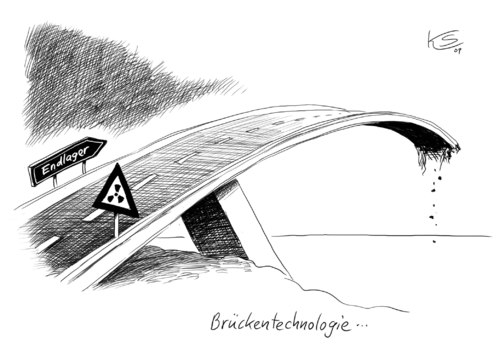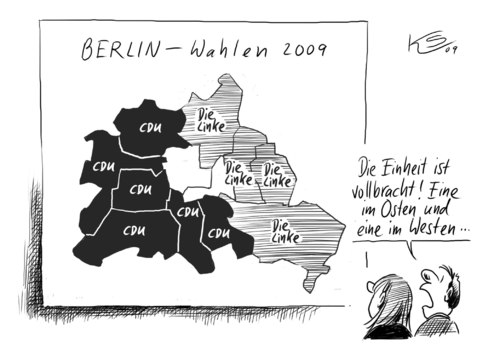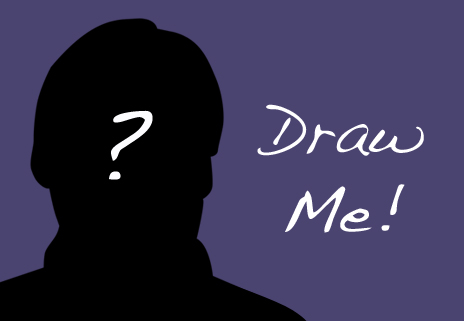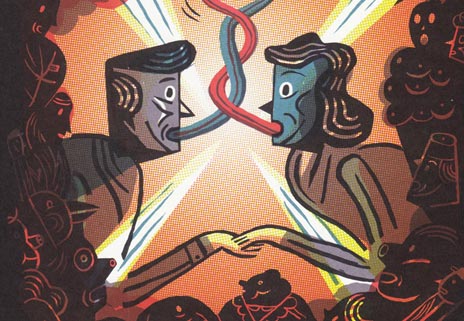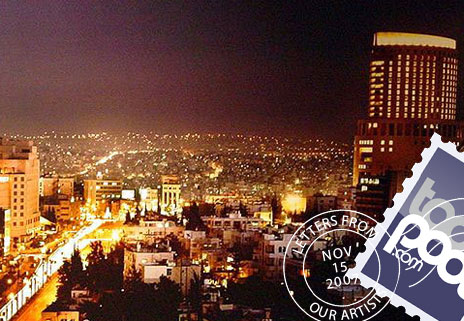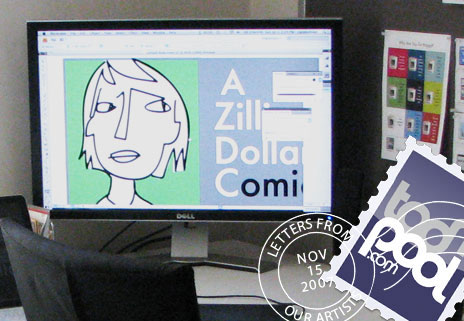[Eine deutsche Version des Interviews finden sie auf der ersten Seite dieses Posts]
Klaus Stuttmann is drawing for Berlin’s Tagesspiegel on a daily basis. His editorial cartoons are beig published in over 20 German newspapers. Stuttmann (b. 1949) grew up in Stuttgart and moved to West Berlin in 1970.
![]() Mr. Stuttmann, on October 18, 2009 an exhibition named “Klaus Stuttman: Editorial Cartoons from the Capital” opened in Hannover’s Wilhelm-Busch-Museum. What exactly is on display there?
Mr. Stuttmann, on October 18, 2009 an exhibition named “Klaus Stuttman: Editorial Cartoons from the Capital” opened in Hannover’s Wilhelm-Busch-Museum. What exactly is on display there?
A selection of my political cartoons in chronological order – beginning in 1989. Until ’89 I have mostly been working for the SEW (the Socialist Unity Party of West Berlin). When the Berlin Wall came down, that part of my life was over and I had to start something new. In this respect, 1989 meant a turning point for myself. The way I am working has changed very much after that.
But you did draw caricatures before that?
Yes. But I couldn’t earn a living from it. I only worked for a single newspaper, the SEW’s Die Wahrheit (“The Truth”) and they couldn’t pay much. I did posters and layout jobs to pay my rent. After the wall fell, the scene I had been working for disbanded. SEW was a subsidiary of East Germany’s SED (Socialist Unity Party of Germany) and, of course, they had provided all the money. When SED disbanded, everything here fell apart as well and I was unemployed.
Did you apply for a job at the Tagesspiegel right away?
No, first I applied with TAZ and shortly after with Leipziger Volkszeitung and Junge Welt. Both Leipziger Volkszeitung and Junge Welt demanded daily cartoons. I had never done this before and I thought that this would be nearly impossible.
I was surprised to learn that you are doing all your drawing digitally – your works look pretty hand-crafted.
Well, “digitally” still means “hand-crafted”. I draw my cartoons the traditional way – I only use a computer instead of paper.
When did you switch to digital ink?
Around 2000. I used the money I won at the Rückblende ’99 competition to buy an Apple computer and a graphic tablet and I started to learn Photoshop.
Did the new technology change the way you are working?
I would say that my drawings have gotten better these days. I don’t have to be afraid anymore to draw a wrong line. Everything’s faster and more laid-back now. I simply enjoy drawing more than I did before and I think people can tell. My style, on the other hand, didn’t change much.
You enjoy drawing more now… does that mean that you didn’t really like it so much before?
No, no. But I’m not really good at drawing. In the past, I frequently was at the brink of desperation when drawings didn’t work out. This doesn’t happen anymore.
Do you still use ink at all?
Nope. I couldn’t get the technique right in the first place. Standard nibs would get stuck or clogged. I often ended up throwing my pen at the wall. Later on, I started using technical pens, but they can’t produce dynamic lines so everything looks dead in a way. These days, I am doing everything in Photoshop. I will use paper and pencils for sketches when I’m not at home but only to keep me from forgetting ideas I might get.
I noticed that you receive a lot of feedback in your website…
That depends, sometimes there’s not a single comment for days and sometimes there are a lot of them. The comments can be annoying at times, for example, when schoolkids use my guestbook as a forum for something totally unrelated and I have to delete all the postings. During the Muhammad cartoons controversy, I was harshly attacked by Islamist people. There would be a new comment every two minutes, some of them containing severe threats. After a week we shut down the page, because we couldn’t take it anymore. I had to hide for some time because of the death threats, leave my apartment.
Such extreme cases left aside, do the comments influence you work?
Hardly. The suggestions people will send me differ so much that I would have to split myself in two. Of course I will consider all legitimate comments and often try to write a response.
Your exhibition at the Wilhelm-Busch-Museum is titled “Editorial Cartoons from the Capital”; does Berlin have a special meaning for your art?
Well, you could say that Berlin is important for my work because it is the seat of government – I mostly do cartoons about domestic policy. Of course this is partly due to my job for the Tagesspiegel. They focus on domestic policy rather than on foreign policy. For a cartoon, I always have to rely on what information my readers already have, otherwise it wouldn’t work. You can’t explain every single thing in the cartoon. Since few people are familiar with foreign policy issues – take South America, for example – cartoons about those wouldn’t work.
Has your work gotten easier after the Federal Elections? Is it easier to do Cartoons about the CDU and the FDP?
Actually there’s hardly any difference. Sometimes doing cartoons about the SPD did hurt a little, but that’s the way it goes. With the Christian Democrats and the Liberal Party nothing will hurt. Maybe that’s a small difference.
Guido Westerwelle (FDP) already got some negative publicity after the election..
He’s always been a figure of ridicule, but maybe that will change. Nobody took Angela Merkel serious in the at the beginning, or Helmut Kohl for that matter.
The way Mr. Kohl has been depicted did change over time…
… As did the portrayal of Mrs Merkel over the last ten years. As a caricaturist you can’t help noticing a striking phenomenon: In the beginning you try to achieve a maximum likeness when drawing politicians, so people can recognize them. Towards the end of their careers it’s the other way round: You simply draw them and life has imitated art in a way (laughing). The most extreme example was Theo Waigel. In the end, caricaturists would only draw his eyebrows. When he started, nobody would have gotten that but in the end people would look at his face and see nothing but eyebrows.
Thanks for your time!
Paul Hellmich
Pages: 1 2
© toonpool.com